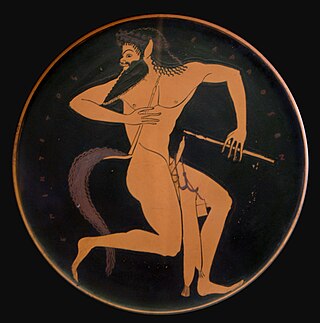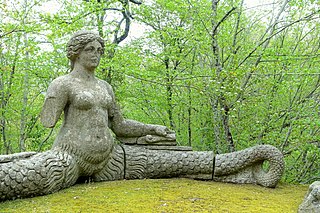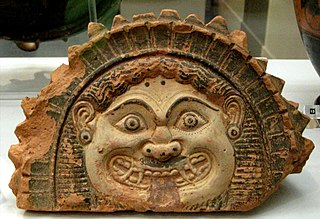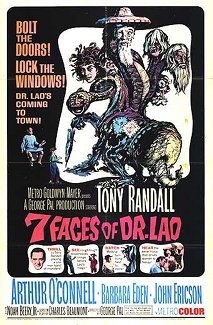
In Greek mythology, a satyr, also known as a silenus or silenos, and selini (plural), is a male nature spirit with ears and a tail resembling those of a horse, as well as a permanent, exaggerated erection. Early artistic representations sometimes include horse-like legs, but, by the sixth century BC, they were more often represented with human legs. Comically hideous, they have mane-like hair, bestial faces, and snub noses and they always are shown naked. Satyrs were characterized by their ribaldry and were known as lovers of wine, music, dancing, and women. They were companions of the god Dionysus and were believed to inhabit remote locales, such as woodlands, mountains, and pastures. They often attempted to seduce or rape nymphs and mortal women alike, usually with little success. They are sometimes shown masturbating or engaging in bestiality.
The serpent, or snake, is one of the oldest and most widespread mythological symbols. The word is derived from Latin serpens, a crawling animal or snake. Snakes have been associated with some of the oldest rituals known to humankind and represent dual expression of good and evil.

Apollonius of Tyana was a first-century Greek philosopher and religious leader from the town of Tyana, Cappadocia in Roman Anatolia, who spent his life travelling and teaching in the Middle East, North Africa and South Asia. He is a central figure in Neopythagoreanism and was one of the most famous "miracle workers" of his day.

In Greek mythology, Echidna was a monster, half-woman and half-snake, who lived alone in a cave. She was the mate of the fearsome monster Typhon and was the mother of many of the most famous monsters of Greek myth.
Empusa or Empousa is a shape-shifting female being in Greek mythology, said to possess a single leg of copper, commanded by Hecate, whose precise nature is obscure. In Late Antiquity, the empousai have been described as a category of phantoms or spectres, equated with the lamiai and mormolykeia, thought to seduce and feed on young men.

A Gorgon is a creature in Greek mythology. Gorgons occur in the earliest examples of Greek literature. While descriptions of Gorgons vary, the term most commonly refers to three sisters who are described as having hair made of living, venomous snakes and horrifying visages that turned those who beheld them to stone. Traditionally, two of the Gorgons, Stheno and Euryale, were immortal, but their sister Medusa was not and was slain by the demigod and hero Perseus.
Mormo was a female spirit in Greek folklore, whose name was invoked by mothers and nurses to frighten children to keep them from misbehaving.

According to Greek mythology, the Chimera, Chimaera, or Chimæra was a monstrous fire-breathing hybrid creature from Lycia, Asia Minor, composed of different animal parts. It is usually depicted as a lion, with the head of a goat protruding from its back, and a tail that might end with a snake's head. It was an offspring of Typhon and Echidna and a sibling of monsters like Cerberus and the Lernaean Hydra.

In Mesopotamian religion, Tiamat is a primordial goddess of the sea, mating with Abzû, the god of the groundwater, to produce younger gods. She is the symbol of the chaos of primordial creation. She is referred to as a woman and described as "the glistening one". It is suggested that there are two parts to the Tiamat mythos. In the first, she is a creator goddess, through a sacred marriage between different waters, peacefully creating the cosmos through successive generations. In the second Chaoskampf Tiamat is considered the monstrous embodiment of primordial chaos. Some sources identify her with images of a sea serpent or dragon.

In Greek mythology, Perseus is the legendary founder of the Perseid dynasty. He was, alongside Cadmus and Bellerophon, the greatest Greek hero and slayer of monsters before the days of Heracles. He beheaded the Gorgon Medusa for Polydectes and saved Andromeda from the sea monster Cetus. He was the son of Zeus and the mortal Danaë, as well as the half-brother and great-grandfather of Heracles.

In Greek mythology, Medusa, also called Gorgo, was one of the three Gorgons. Medusa is generally described as a human female with living venomous snakes in place of hair; those who gazed into her eyes would turn to stone. Most sources describe her as the daughter of Phorcys and Ceto, although the author Hyginus makes her the daughter of Gorgon and Ceto.

Lamia, in ancient Greek mythology, was a child-eating monster and, in later tradition, was regarded as a type of night-haunting spirit (daemon).

Rattler is a fictional character appearing in American comic books published by Marvel Comics. He first appeared in Captain America #310, created by writer Mark Gruenwald and artist Paul Neary. The name Rattler was also used by two Marvel comics characters from the Wild West era, both enemies of the Rawhide Kid. A fourth Rattler appeared in the Spider-Man newspaper comic strip, who gained power by being bitten by a snake and then treated with an experimental anti-venom.
Charles Grandison Finney was an American news editor and fantasy novelist, the great-grandson of evangelist Charles Grandison Finney. His first novel and most famous work, The Circus of Dr. Lao, won one of the inaugural National Book Awards: the Most Original Book of 1935.

7 Faces of Dr. Lao is a 1964 American Metrocolor Western fantasy-comedy film directed by George Pal and starring Tony Randall. The film, an adaptation of the 1935 novel The Circus of Dr. Lao by Charles G. Finney adapted for the screen by Charles Beaumont, details the visit of a magical circus to a small town in the southwestern United States and its effects on the townspeople.

Chimera is a 1972 fantasy novel written by American writer John Barth, composed of three loosely connected novellas. The novellas are Dunyazadiad, Perseid and Bellerophoniad, whose titles refer eponymously to the mythical characters Dunyazad, Perseus and Bellerophon. The book is an example of postmodernism, which can be seen in its metafictional content and its incorporation of stylistic elements that go beyond the traditional novel genre. It shared the U.S. National Book Award for Fiction with Augustus by John Edward Williams.

Princess Python is a supervillain appearing in American comic books published by Marvel Comics.












